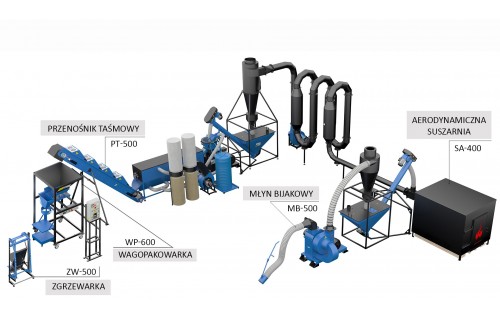Proces produkcji pelletu opałowego

Według danych zgromadzonych przez
Centralną Ewidencję Emisyjności Budynków, w Polsce jest zarejestrowanych ponad
400 tysięcy kotłów na pellet. Możemy przyjąć, że zapotrzebowanie na to paliwo
pokrywa się z roczną produkcją, szacowaną na ok. 2 mln ton. Ze względu na
zeszłoroczne turbulencje związane z podażą i ceną pelletu wielu potencjalnych
producentów, dystrybutorów
i użytkowników wstrzymuje się z zakupem linii do produkcji pelletu jak i samego
pelletu, tłumacząc,
że pellet jest zbyt drogi.
Czym jest pellet i z czego powstaje?
Pellet jest paliwem opałowym,
które powstaje z wolnych od chemii produktów ubocznych z tartaków
i stolarni. Są to trociny, wióry i zrębka pochodzące zarówno z obróbki drewna
iglastego jak i liściastego. Pellet jest granulatem, którego średnica wynosi z
reguły 6 lub 8 milimetrów. Ta wielkość pelletu jest optymalna dla automatycznego
napełniania kotła grzewczego i zapewnia czyste spalanie jak i również obsługę.
Zalety i wady pelletu
Nie ma żadnych wątpliwości, że
dla odbiorcy końcowego pellet jest korzystnym energetycznie paliwem, którego
wartość energetyczna (19MJ/kg) jest nieznacznie niższa od wartości
energetycznej węgla (23 MJ/kg) . Z ekologicznego punktu widzenia jest
odnawialnym paliwem, które przyczynia się do zrównoważonego rozwoju, a dla
konsumenta oznacza wygodę wynikającą z mniejszego zaangażowania w utrzymanie i serwis kotła grzewczego.
Pod względem bilansu
ekologicznego i zrównoważonego rozwoju produkcja pelletu jest uzasadniona
wtedy, jeżeli surowcem są odpady drewna, a nie surowiec pozyskiwany w wyniku
wylesiania. Stąd też ekolodzy kładą nacisk na to, aby do produkcji pelletu nie
używać całych kłód.
Innym ważnym aspektem postrzeganym przez konsumentów jako wada jest
niestabilność ceny pelletu w ostatnich latach. Na ceny należy jednak zawsze
patrzeć w dłuższej perspektywie.
Proces wytwarzania pelletu
Produkcja tego paliwa odbywa się
na zasadzie kompresji surowca jakim są np. wióry czy też trociny.
Do wyprodukowania jednej tony pelletu potrzeba z reguły 6-8 m3 surowca.
Ostateczny rezulat zależy od właściwości fizycznych takich jak np. wilgotność i
gęstość.
Pierwszym etapem w procesie
produkcji jest oczyszczenie surowca od niepożądanych zanieczyszczeń. Mogą to
być cząsteczki różych metali lub kamienie. Do tego służą separatory metali i
materiałów ciężkich. W przypadku czystego surowca etap ten można pominąć.
Następnie ze względu na różnorodność surowca pod względem wielkości jest on kierowany do młyna bijakowego, w
którym uzyskujemy jednorodną frakcję.
W drugim etapie surowiec podlega
procesowi suszenia. Z reguły trociny, wióry i zrębka mają zdecydowanie wyższą
wilgotność jak ta wymagana. Dochodzi ona nawet do poziomu ok. 40%-50%. Po
wysuszeniu wilgotność surowca spada nawet do 10% i jest to parametr decydujący
o jakości pelletu
i jego późniejszego czystego spalania w kotle.
Kolejnym etapem jest
kondycjonowanie surowca. Przeważnie odbywa się to poprzez dodanie niewielkiej
ilości wody już w samym procesie peletyzowania, niemniej niektórzy
producenci dodają wcześniej różnego
rodzaju środki wspierające wytwarzanie pelletu, takie jak skrobia lub mąkę.
Następny etap przebiega już w
samej matrycy peleciarki. Miękki surowiec jest wprasowywany pod wysokim
ciśnieniem w otwory matrycy za pomocą rolek, a wychodzący z nich gotowy pellet
jest przycinany na zadaną długość za
pomocą noży. W czasie procesu peletyzacji na styku matrycy i rolek panuje
temperatura w przedziale 60°C -80°C. Powoduje ona, że zawarta w surowcu
lignina, bedąca naturalnym spoiwem, przyczynia się do uformowania i związania
pelletu.
Piątym etapem jest schłodzenie
finalnego produktu. Granulki pelletu schładzają się na wolnym powietrzu.
Chłodzenia może być zintensyfikowane za pomocą dodatkowych wentylatorów
zamontowanych na przenośniku taśmowym. W procesie chłodzenia wiązania krzepną i
stają się stabilne. Dzięki temu pellet zachowuje swój kształt aż do momentu
spalenia w kotle, piecu lub kominku.
Ostatnim etapem jest
przesiewanie. Kurz i niewłaściwie sprasowany pellet zostają odseparowane
i skierowane ponownie do procesu produkcji, natomiast dobry pellet zostaje
zapakowany w worki lub przetransportowany do zasobnika/silosu jako luźny towar.
Finalny produkt może być poddany
certyfikacji. W zależności od zawartości popiołu, związków azotu
i wartości opałowej oraz wilgotności, pellet opałowy jest dzielony względem 3
klas jakościowych.
Pellet klasy A1 gwarantuje najwyższą jakość i oferowany jest głównie do
klientów indywidualnych. Pellet klasy A2 jest pelletem sredniej jakości i znajduje zastosowanie głównie w dużych
instalacjach grzewczych. Pellet klasy B stosowany jest głównie w kotłach
wyposażonych w samoczyszczący palnik.
Linia do produkcji pelletu firmy TechnoMaszBud Sp. z o.o.



